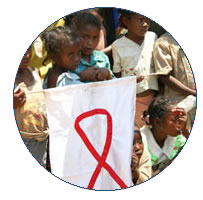Antiretroviral
Therapy Is Effective for Children with HIV in both Wealthy
and Resource-Limited Settings
 |
 |
 |
 |
 |
 |
 |
| SUMMARY:
Overall mortality and deaths due to opportunistic
illness dropped dramatically among U.S.
children with
HIV after the introduction of highly
active antiretroviral therapy (HAART)
in the mid-1990s, according to data from
a large cohort study. However, the death
rate remains 30 times higher than that of
uninfected children, largely attributable
to non-AIDS-defining infections and organ
failure. A related systemic analysis found
that among HIV-infected children in resource-limited
countries, virological and immunological
responses to HAART were similar to those
of children in wealthier areas. |
|
 |
 |
 |
 |
 |
 |
 |
By
Liz Highleyman
 In
the first study, published in the January
1, 2009 Journal of Acquired Immune Deficiency Syndromes,
investigators with the Pediatric AIDS Clinical Trials
Group 219/219C team evaluated changes in the causes
and risk factors for death among children with HIV-1
infection.
In
the first study, published in the January
1, 2009 Journal of Acquired Immune Deficiency Syndromes,
investigators with the Pediatric AIDS Clinical Trials
Group 219/219C team evaluated changes in the causes
and risk factors for death among children with HIV-1
infection.
This multicenter, prospective cohort study enrolled
3553 HIV-infected children and adolescents (up to
age 21) between April 1993 and December 2006. The
median follow-up period was 5.3 years.
Results
 |
A
total of 298 study participants died during the
observation period. |
 |
Death
rates decreased significantly between 1994 and
2000, from 7.2 to 0.8 per 100 person-years. |
 |
After
2000, mortality rates remained relatively stable
through 2006. |
 |
Over
time, the mean age at the time of death roughly
doubled, rising from 8.9 years in 1994 to 18.2
years in 2006. |
 |
The
most common causes of death were "end-stage
AIDS" (48 children, 16%) and pneumonia (41
children, 14%). |
 |
The
proportion of deaths due to opportunistic infections
(OIs) declined from 37% in 1994-1996 to 24% after
2000. |
 |
While
all OI mortality declined during the study period,
the decrease was greater for deaths due to Mycobacterium
avium complex and cryptosporidiosis. |
 |
In
contrast, deaths due to "end-stage AIDS,"
sepsis (systemic infection), and kidney failure
increased. |
 |
After
adjusting for other factors, increased risk of
death was associated with low CD4 count and presence
of AIDS-defining illness at study entry. |
 |
Later
birth cohorts and children who initiated HAART
were significantly less likely to die than untreated
participants (hazard ratio 0.54; P < 0.001).
|
"Overall death rates declined from 1993 to 2000
but have since stabilized at rates about 30 times
higher than for the general U.S. pediatric population,"
the study authors concluded.
"Deaths due to OIs have declined," they
continued, "but non-AIDS-defining infections
and multi-organ failure remain major causes of mortality
in HIV-1-infected children."
Coauthor Lynne Mofenson noted that while "most
HIV-infected children now reach adulthood," it
is not yet clear whether they will go on to have a
normal lifespan. "Currently, we don't have the
means to prevent all the complications of HIV infection,"
she said.
Resource-limited
Settings
As described in the second report, published in the
December
15, 2009 issue of Clinical Infectious Diseases,
Andrea Ciaranello from Massachusetts General Hospital
and colleagues performed a systematic review and meta-analysis
of published studies of treatment response among treatment-naive
children aged 0-17 years.
The investigators searched the Medline, EMBASE, and
LILACS (Latin American and Caribbean Health Sciences
Literature) electronic databases and the Cochrane
Clinical Trials Register to identify relevant studies
conducted in resource-limited countries in Africa,
Asia, Latin America, and the Caribbean.
They used this data to calculate pooled estimates
of the proportions of children who achieved HIV RNA
< 400 copies/mL and CD4 percentage (CD4%) increases
after 12 months on treatment (in young children, CD4%
is considered a more accurate marker of immune status
than absolute CD4 count).
Out of a total of 5928 children who started ART, about
80% did not have viral load data and about 70% were
missing CD4% data at 12 months; to approximate an
intent-to-treat analysis, children with missing 12-month
data were assumed to have HIV RNA > 400 copies/mL
and/or no change in CD4%.
Results
 |
Based
on 1097 participants in 9 studies with complete
data, the pooled proportion of children with virological
suppression was 70%. |
 |
Based
on 1839 children in 12 studies with complete data,
the pooled CD4% increase was 13.7%. |
 |
In
the approximated intent-to-treat analysis, the
estimated pooled proportion with HIV RNA <
400 copies/mL decreased to 53%. |
 |
In
this type of analysis, the estimated pooled CD4%
increase was 8.5%. |
These
results fall within ranges previously reported from
studies of children with HIV in North American and
Europe (53%-84% with virological suppression; CD4%
gain of 10%-13%).
"Pooled estimates of reported virologic and immunologic
benefits after 12 months of ART among HIV-infected
children in resource-limited settings are comparable
with those observed among children in developed settings,"
the researchers concluded.
1/12/10
References
MT
Brady, JM Oleske, PL Williams, and others (Pediatric
AIDS Clinical Trials Group219/219C Team). Declines
in Mortality Rates and Changes in Causes of Death
in HIV-1-infected Children During the HAART Era. Journal
of Acquired Immune Deficiency Syndromes 53(1):
86-94 (Abstract).
January 1, 2009.
AL
Ciaranello, Y Chang, AV Margulis, and others. Effectiveness
of Pediatric Antiretroviral Therapy in Resource-Limited
Settings: A Systematic Review and Meta-analysis. Clinical
Infectious Diseases 49(12): 1915-1927 (Abstract).December
15, 2009.